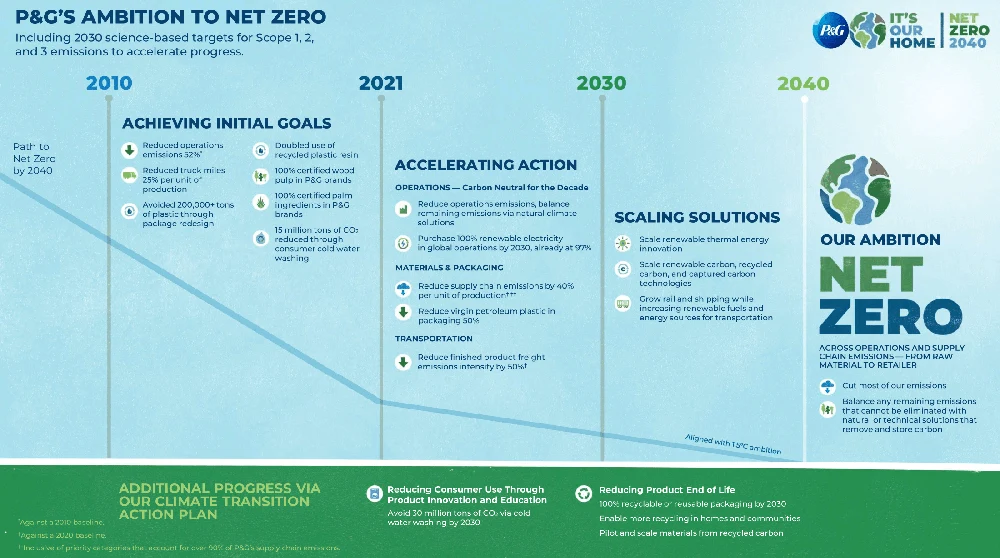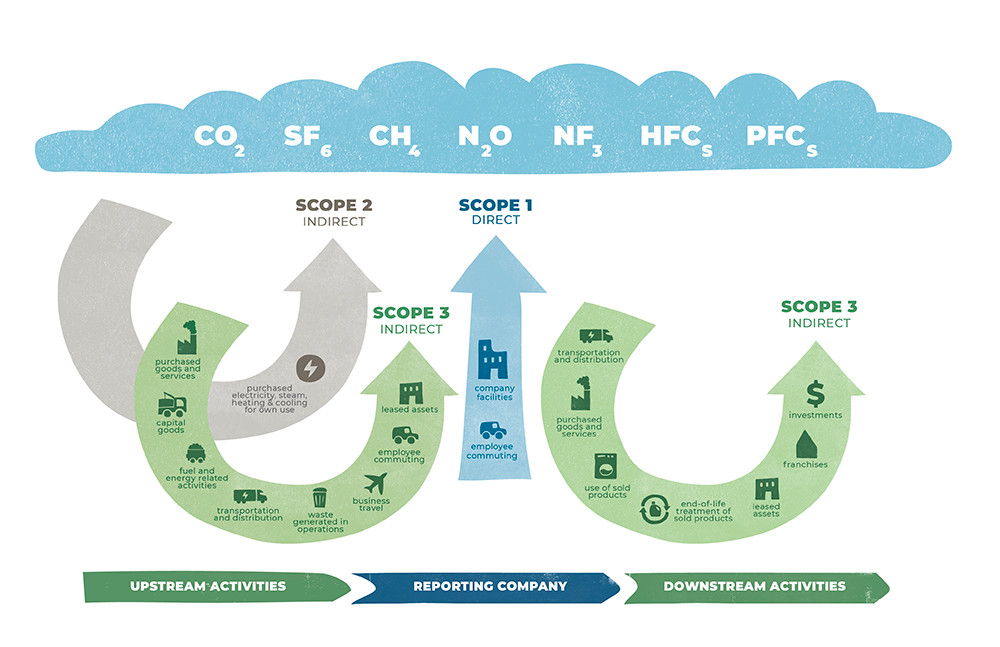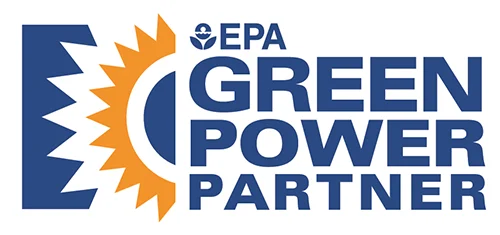9/15/2021
A Closer Look at P&G’s Net Zero 2040 Ambition
In September 2021, P&G announced an ambition to achieve net zero greenhouse gas (GHG) emissions across our supply chain and operations by 2040, from raw material to retailer. We also set science-based interim targets for 2030 to keep us on track and make meaningful progress this decade. But what exactly does it all mean? Let’s break it down:

The Time to Act is Now
The climate crisis affects every home and family, everywhere in the world. The majority of consumers globally now want brands they buy to help them live a more environmentally conscious lifestyle, and the IPCC’s Sixth Assessment Report made it clear that decisive action must be taken to avoid the most significant impacts of climate change. This means that all of us, including businesses and governments, need to step up and drastically reduce our collective GHG emissions. We may not have all the answers, but we will not let uncertainty hold us back.
P&G is a company deeply rooted in science, and the climate crisis requires bold goals supported by credible, science-based actions. Our actions on climate began over a decade ago, and we know there is more work to do. Our net zero ambition reaffirms our priorities to reduce emissions now, with the tools available to us today, as well as innovate toward continued reductions in the future. Our new Climate Transition Action Plan outlines our comprehensive efforts to accelerate climate action throughout our value chain.
Achieving Net Zero by 2040: The Scoop on
Scopes 1, 2, and 3

How much of your emissions is P&G planning to reduce to achieve its 2040 net zero ambition?
We will prioritize cutting most of our emissions across our operations and supply chain, from raw material to retailer. For residual emissions in these categories that cannot be eliminated, we will use natural or technical solutions that remove and store carbon. As a science-based company, we are following the current guidance from the Science-Based Targets Initiative (SBTi) for net zero with at least a 90 percent reduction in emissions as a frame of reference and will provide an update as we make progress.
Does P&G’s net zero ambition address all three emissions scopes?
The scope of our net zero ambition includes our operations and supply chain. In formal GHG accounting terminology, this means the following categories of emissions are covered:
- Scope 1: Direct GHG emissions from P&G sites;
- Scope 2: Emissions associated with purchased energy for P&G sites;
- Scope 3: Emission categories associated with purchased goods and services; upstream transportation and distribution (inbound transportation of raw materials from Tier I suppliers and outbound transportation of finished products to retail partners).
The scope of our net zero ambition aligns with recommendations from the Climate Action 100+ Net Zero Benchmark, guidance put out by the investor-led initiative to assess the world's largest companies on their progress toward net zero.
Is P&G addressing emissions in the consumer use phase?
Yes, we are going beyond our net zero ambition to separately address the consumer use phase as part of our Climate Transition Action Plan. The largest portion of our carbon footprint comes from consumer use of our products, so it is an important priority for us to address. To learn more about some of the ways we’re doing this, see “Opportunities to Influence Collective Action” below.
How can we track P&G’s progress toward net zero?
As we advance on our journey, you can expect us to be transparent – sharing our successes and setbacks along the way so we can all make progress together. We will update our Climate Transition Action Plan as new technologies, solutions, and standards arise. We will share progress toward our goals via our ESG Investor Portal. We also plan to continue to issue reports aligned with recommendations from the Task Force on Climate Related Financial Disclosures (TCFD) and share climate related information via the CDP Climate Survey.
Working Toward Net Zero: 2030 Targets

While establishing a bold long-term ambition is critical, we think it’s just as important to have clear, credible interim targets to ensure we are making meaningful progress this decade. That’s why we’ve set 2030 targets submitted to SBTi for each element of our net zero ambition, including:
Our Operations: Reducing Scope 1 and 2 emissions by 50 percent by 2030 vs. 2010 baseline
We’ve been working hard to reduce the GHG emissions from P&G sites. In 2020, we set a goal to be carbon neutral for the decade across our operations and we’re already making progress.
Our progress and goals include:
- Reducing emissions across our operations. From 2010 to 2020 we have reduced absolute emissions across our global operations 52 percent through energy efficiency and renewable electricity. As we continue to reduce emissions, we are also advancing natural climate solutions to balance any remaining emissions from our operations that cannot be eliminated by 2030. These include new projects that help protect and restore forests and other ecosystems essential to the people and wildlife that call them home. NCS projects generate meaningful impacts on biodiversity, water, food security, and other co-benefits for local communities.
- Accelerating renewable electricity. We are nearing our 2030 goal of purchasing 100 percent renewable electricity by already purchasing 97 percent globally. In 2021, the United States Environmental Protection Agency recognized P&G as #5 on its National Top 100 list of green power users and #2 on its Top 30 list for on-site renewable power generation nationwide, making us top-rated in the consumer products industry.

- Leveraging renewable thermal energy. We use geothermal, solar, and renewable steam at some of our manufacturing sites, but continuing to reduce emissions associated with thermal energy use will require more innovation. We have partnered with the World Wildlife Fund, manufacturers, and local governments to help create the Renewable Thermal Collaborative to identify and scale renewable, cost-competitive thermal energy solutions.
Our Supply Chain: Reducing supply chain emissions from priority categories by 40 percent per unit of production by 2030 vs. 2020 baseline
At P&G, our supply chain emissions are about 10 times that of our operations, which is why we’ve set a goal to reduce scope 3 emissions from priority categories by 40 percent by 2030. Our priority categories account for over 90 percent of our supply chain emissions and include Laundry Detergent, Fabric Enhancers, Shampoo, Conditioners, Body Wash, and Baby Diapers. While these categories are in scope for formal goal tracking and reporting for our 2030 target, all categories company-wide will be activating plans to reduce emissions in pursuit of net zero.
Eliminating Deforestation in our Supply Chain
P&G uses two commodities, palm oil and wood pulp, that are known to have potential deforestation risks in their supply chain. P&G has committed to eliminate deforestation in our supply chain, and we have responsible sourcing programs in place for both palm oil and wood pulp. P&G recently reviewed our programs, accelerated our certification goals, and enhanced our monitoring procedures. Additional details on our sourcing programs can be found at our:
Reducing Our Footprint Across Our Supply Chain
We are aggressively reducing our footprint across our supply chain in several ways:
-
Decarbonizing our supply chain and logistics.
-
P&G established a new Product Supply Innovation Center (PSIC) in Kronberg, Germany as a hub for a network of local suppliers, tech companies, and top universities, developing solutions that are global and scalable to help decarbonize supply chains.
-
We’ve set a goal to increase global upstream finished product freight emissions efficiency by 50 percent by 2030. We will explore a wide range of strategies to do this, including increased use of rail and ship transportation, trucks powered by alternative fuels, and optimized distribution routes. We have also partnered with our logistics suppliers to obtain data that will allow us to track our progress.
-
Our Pampers brand is actively working with suppliers to reduce their carbon footprint and avoided an estimated one million metric tons of GHG from the production of its materials over the past five years.
-
Advancing low-carbon technologies, materials, and packaging. To unlock new ways to decarbonize our supply chain, we are partnering to advance innovation in materials derived from renewable, bio-based, or recycled carbon across brands including Head & Shoulders, Pantene, Ariel, Tide and Pampers.

- Exploring Ingredients made from captured CO2. Our Tide brand is working with Twelve, a Silicon Valley start-up, to explore their carbon transformation technology to incorporate ingredients made from captured CO2 into the manufacturing of Tide. Twelve’s technology converts captured CO2 emissions into chemicals using just water and renewable energy as inputs – creating a potential fossil-free pathway for ingredient sourcing.
Beyond Net Zero: Opportunities to Influence Collective Action
We are going beyond our net zero ambition and doing more to make a collective impact – partnering with consumers to reduce GHG emissions from the use phase of products, creating alliances for carbon-efficient homes, and advocating for policy solutions to decarbonize energy infrastructure. Our efforts here include:
- Making sustainability effortless at home. P&G and its brands will continue to provide consumers with tools and information on how small actions at home can make a world of difference for the planet.

-
Reducing 15 million tons of carbon through cold water washing, and accelerating impact with an additional 30 million tons by 2030. We have leveraged innovation and sustained consumer education to help reduce the largest portion of our carbon footprint – the energy needed to heat water during product use. P&G brands Tide and Ariel have helped consumers increase their use of low-energy laundry cycles to avoid roughly 15 million metric tons of carbon dioxide. Tide and Ariel continue to drive greater use of cold water washing through new education campaigns to help avoid an additional 30 million tons of carbon emissions by 2030 – more than ten times that of P&G’s yearly global operations.
-
Creating the home of the future. We are advancing solutions to decarbonize homes with industry partners via the 50L Home Coalition. The 50L Home Coalition is a global action-oriented platform that convenes leaders from the private, nonprofit and public sectors to develop and scale viable technologies that address two of our most pressing global challenges: water security and climate change. By helping people reduce and track their use of hot water without trade-offs, the Coalition is bringing to life the low-carbon home of the future that can use 10 times less water than most use today – and by extension, less energy to heat that water.
-
We are advocating for policies that will advance the use of renewable energy and reduce the carbon intensity of the energy infrastructure around people’s homes.
The Road Ahead
The next two decades represent a critical window to accelerate action on climate change. We know the task ahead is urgent, difficult, and much bigger than P&G alone, but we’re ready to take on the challenge. We welcome you to follow and work with us on our journey to net zero – for more information and ongoing updates about our commitments and progress, please see our Climate Transition Action Plan, ESG Investor Portal, and 2020 Citizenship Report. Together, we can create a low-carbon future that protects our planet, our common home, for generations to come.



